Natylie Baldwin's Blog, page 7
September 2, 2025
Declassified: CIA’s Covert Ukraine Invasion Plan
By Kit Klarenberg, Substack, 8/17/25
All my investigations are free to access, thanks to the enormous generosity of my readers. Independent journalism nonetheless requires investment, so if you took value from this article or any others, please consider sharing, or even becoming a paid subscriber. Your support is always gratefully received, and will never be forgotten. To buy me a coffee or two, please click this link .
On August 7th, US polling giant Gallup published the remarkable results of a survey of Ukrainians. Public support for Kiev “fighting until victory” has plummeted to a record low “across all segments” of the population, “regardless of region or demographic group.” In a “nearly complete reversal from public opinion in 2022,” 69% of citizens “favor a negotiated end to the war as soon as possible.” Just 24% wish to keep fighting. However, vanishingly few believe the proxy war will end anytime soon.
The reasons for Ukrainian pessimism on this point are unstated, but an obvious explanation is the intransigence of President Volodymyr Zelensky, encouraged by his overseas backers – Britain in particular. London’s reverie of breaking up Russia into readily-exploitable chunks dates back centuries, and became turbocharged in the wake of the February 2014 Maidan coup. In July that year, a precise blueprint for the current proxy conflict was published by the Institute for Statecraft, a NATO/MI6 cutout founded by veteran British military intelligence apparatchik Chris Donnelly.
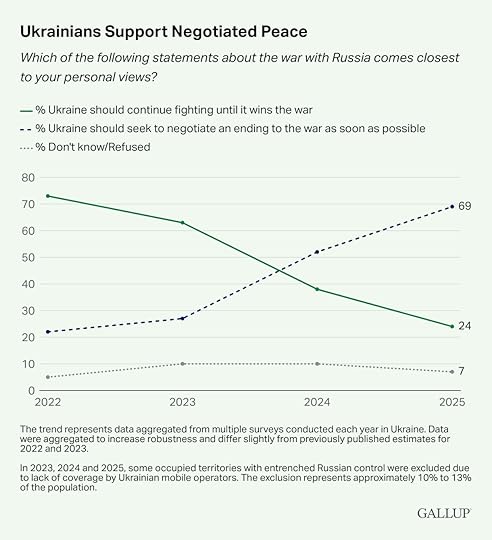
In response to the Donbass civil war, Statecraft advocated targeting Moscow with a variety of “anti-subversive measures”. This included “economic boycott, breach of diplomatic relations,” as well as “propaganda and counter-propaganda, pressure on neutrals.” The objective was to produce “armed conflict of the old-fashioned sort” with Russia, which “Britain and the West could win.” While we are now witnessing in real-time the brutal unravelling of Donnelly’s monstrous plot, Anglo-American designs of using Ukraine as a beachhead for all-out war with Moscow date back far further.
In August 1957, the CIA secretly drew up elaborate plans for an invasion of Ukraine by US special forces. It was hoped neighbourhood anti-Communist agitators would be mobilized as footsoldiers to assist in the effort. A detailed 200-page report, Resistance Factors and Special Forces Areas, set out demographic, economic, geographical, historical and political factors throughout the then-Soviet Socialist Republic that could facilitate, or impede, Washington’s quest to ignite local insurrection, and in turn the USSR’s ultimate collapse.

Cia Rdp81 01043r002300220007 1
33.1MB ∙ PDF file
The mission was forecast to be a delicate and difficult balancing act, as much of Ukraine’s population held “few grievances” against Russians or Communist rule, which could be exploited to foment an armed uprising. Just as problematically, “the long history of union between Russia and Ukraine, which stretches in an almost unbroken line from 1654 to the present day,” resulted in “many Ukrainians” having “adopted the Russian way of life”. Problematically, there was thus a pronounced lack of “resistance to Soviet rule” among the population.
The “great influence” of Russian culture over Ukrainians, “many influential positions” in local government being held “by Russians or Ukrainians sympathetic to [Communist] rule, and “relative similarity” of their “languages, customs, and backgrounds”, meant there were “fewer points of conflict between the Ukrainians and Russians” than in Warsaw Pact nations. Throughout those satellite states, the CIA had to varying success already recruited clandestine networks of “freedom fighters” as anti-Communist Fifth Columnists. Yet, the Agency remained keen to identify potential “resistance” actors in Ukraine:
“Some Ukrainians are apparently only slightly aware of the differences which set them apart from Russians and feel little national antagonism. Nevertheless, important grievances exist, and among other Ukrainians there is opposition to Soviet authority which often has assumed a nationalist form. Under favorable conditions, these people might be expected to assist American Special Forces in fighting against the regime.”
‘Nationalist Activity’
A CIA map split Ukraine into 12 separate zones, ranked on “resistance” potential, and how “favorable population attitudes [are] toward the Soviet regime.” South and eastern regions, particularly Crimea and Donbass, rated poorly. Their populations were judged “strongly loyal” to Moscow, having never “displayed nationalist feelings or indicated any hostility to the regime,” while viewing themselves as “a Russian island in the Ukrainian sea.” In fact, as the study recorded, during and after World War I, when Germany created a fascist puppet state in Ukraine:
“Inhabitants of Donbass strongly resisted Ukrainian nationalists and at one point created a separate republic, independent of the rest of Ukraine. In the following years, they defended Soviet rule and Russian interests, often attacking the Ukrainian nationalists with more zeal than the Russian leaders themselves. During the German occupation in the Second World War, there was not a single recorded case of support for the Ukrainian nationalists or Germans.”
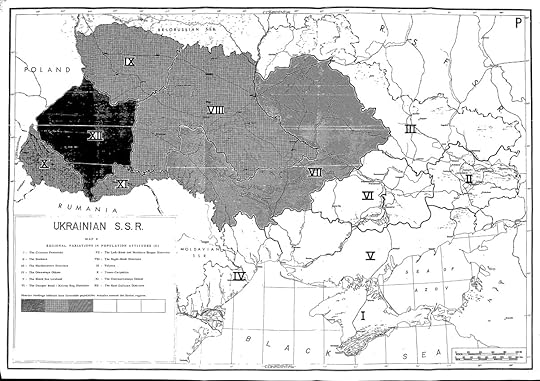
Still, invading and occupying Crimea was considered of paramount importance. On top of its strategic significance, the peninsula’s landscape was forecast as ideal for guerrilla warfare. The terrain offered “excellent opportunities for concealment and evasion,” the CIA report noted. While “troops operating in these sectors must be specially trained and equipped,” it was forecast the local Tatar population, “which fought so fiercely” against the Soviets in World War II, “would probably be willing to help” invading US forces.
Areas of western Ukraine, including former regions of Poland such as Lviv, Rivne, Transcarpathia and Volyn, which were heavily under control of “Ukrainian insurgents” – adherents of MI6-supported Stepan Bandera – during World War II, were judged most fruitful “resistance” launchpads. There, “nationalist activity was extensive” during World War II, with armed militias opposing “pro-Soviet partisans with some success.” Conveniently too, mass extermination of Jews, Poles and Russians by Banderites in these regions meant there was virtually no non-ethnic Ukrainian population left.
Furthermore, in the post-war period, “resistance to Soviet rule” had been “expressed on a great scale” in western Ukraine. Despite “extensive deportations”, “many nationalists” resided in Lviv et al, and “nationalist cells” created by Bandera’s “task forces” were dotted around the Republic. For example, anti-Communist “partisan bands” had taken up residence in the Carpathian Mountains. The review concluded, “it is in this region [US] Special Forces could expect considerable support from the local Ukrainian population, including active participation in measures directed against the Soviet regime.”
It was also determined that “Ukrainian nationalist, anti-Soviet sentiment” in Kiev was “apparently moderately strong,” and elements of the population “might be expected to provide active assistance to Special Forces.” The capital’s “large Ukrainian population” was reportedly “little affected by Russian influence,” and during the Russian Revolution “provided greater support than any other region for Ukrainian, nationalist, anti-Soviet forces.” Resultantly, “uncertainty about the attitudes of the local population” prompted Moscow to designate Kharkov the Ukrainian SSR’s capital, which it remained until 1934.
The CIA document further offered highly detailed assessments of Ukrainian territory, based on their utility for warfare. For example, “generally forbidding” Polesia – near Belarus – was noted to be “almost impossible” to traverse during spring. Conversely, winter provided “most favorable to movement, depending on the depth to which the ground freezes.” Overall, the area had “proved its worth as an excellent refuge and evasion area by supporting large-scale guerilla activities in the past.” Meanwhile, “swampy valleys of the Dnieper and Desna rivers” were of particular interest:
“The area is densely forested in its north-western part, where there are excellent opportunities for concealment and manoeuvre…There are extensive swamps, interspersed with patches of forest, which also provide good hiding places for the Special Forces. Conditions in the Volyno-Podolskaya Highlands are less suitable, although small groups may find temporary shelter in the sparse forests.”
‘Strongly Anti-Nationalist’
The CIA’s invasion plan never formally came to pass. Yet, areas of Ukraine forecast by the Agency to be most welcoming of US special forces were precisely where support for the Maidan coup was highest. Moreover, in a largely unknown chapter of the Maidan saga, fascist Right Sector militants were bussed en masse to Crimea prior to Moscow’s seizure of the peninsula. Had they succeeded in overrunning the territory, Right Sector would’ve fulfilled the CIA’s objective, as outlined in Resistance Factors and Special Forces Areas.
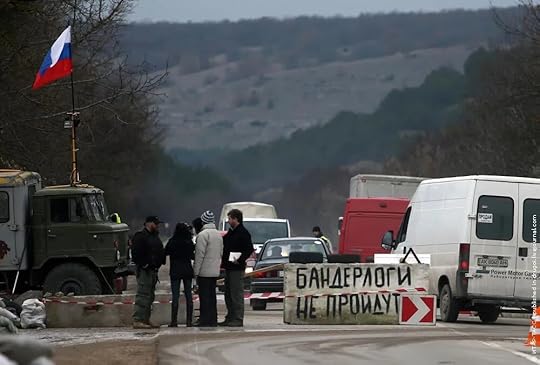 A civilian defence barricade constructed to prevent Right Sector entering Crimea, February 2014
A civilian defence barricade constructed to prevent Right Sector entering Crimea, February 2014Given what transpired elsewhere in Ukraine following February 2014, other sections of the CIA report take on a distinctly eerie character. For instance, despite its strategic position facing the Black Sea, the Agency warned against attempting to foment anti-Soviet rebellion in Odessa. The agency noted the city is “the most cosmopolitan area in Ukraine, with a heterogeneous population including significant numbers of Greeks, Moldovans and Bulgarians, as well as Russians and Jews.” As such:
“Odessa…has developed a less nationalistic character. Historically, it has been considered more Russian than Ukrainian territory. There was little evidence of nationalist or anti-Russian sentiment here during the Second World War, and the city…was in fact controlled by a strongly anti-nationalist local administration [during the conflict].”
Odessa became a key battleground between pro- and anti-Maidan elements, from the moment the protests erupted in November 2013. By March the next year, Russophone Ukrainians had occupied the city’s historic Kulykove Pole Square, and were calling for a referendum on the establishment of an “Odessa Autonomous Republic”. Tensions came to a head on May 2nd, when fascist football ultras – who subsequently formed Azov Battalion – stormed Odessa and forced dozens of anti-Maidan activists into Trade Unions House, before setting it ablaze.
In all, 42 people were killed and hundreds injured, while Odessa’s anti-Maidan movement was comprehensively neutralised. In March this year, the European Court of Human Rights issued a damning ruling against Kiev over the massacre. It concluded local police and fire services “deliberately” failed to respond appropriately to the inferno, and authorities insulated culpable officials and perpetrators from prosecution despite possessing incontrovertible evidence. Lethal “negligence” by officials on the day, and ever after, was found to go far “beyond an error of judgment or carelessness.”
The ECHR was apparently unwilling to consider the incineration of anti-Maidan activists was an intentional and premeditated act of mass murder, conceived and directed by Kiev’s US-installed fascist government. However, the findings of a Ukrainian parliamentary commission point ineluctably towards this conclusion. Whether, in turn, the Odessa massacre was intended to trigger Russian intervention in Ukraine, thus precipitating “armed conflict of the old-fashioned sort” with Moscow that “Britain and the West could win” is a matter of speculation – although the Institute for Statecraft was present in the country at the time.
September 1, 2025
Ted Snider: How Far Will Putin Compromise?
By Ted Snider, The American Conservative, 8/28/25
The attempt to isolate Russia and its president, Vladimir Putin, has never been a smashing success. Nevertheless, it has been a key component of the West’s response to the Russian invasion of Ukraine, and it’s proved out of touch and unaligned with the emerging multipolar reality. Outside the West, America’s arrogant attempt to enforce its hegemony did the opposite of isolating Russia, pushing it into closer and firmer relations with China, India, Africa, and the broader BRICS+ community. Within the West, the isolation of Putin and Russia was much more successful.
But on August 15, that isolation was shattered. Putin’s plane landed on American soil for the first in-person talks between the leaders of Russia and the U.S.—indeed, the first major talks between Putin and any Western leader—since the war in Ukraine began.
The summit, held in Alaska, seems to have been a success, assuming realistic expectations of a first “feel-out meeting,” as Trump called it. Going into the summit, Trump offered some metrics for evaluating whether it was going well. The president said he would know how it would go in the first minutes. After Putin arrived, Trump looked him in the eye, laughed, warmly shook Putin’s hand, and invited him to ride in his presidential limousine. Trump also said that if the summit went well, he would talk to the press with Putin; if it went badly, he would address them alone. The leaders spoke together. Trump added that if it wasn’t a success, there would be severe consequences for Russia. After the summit, the threatened sanctions were off, for now (though secondary tariffs targeting India remained).
Putin, for his part, said they had reached an understanding that he hoped could help bring about peace. Trump insisted the meeting was “extremely productive” and that “many points were agreed upon with only a very few left unresolved.” One unnamed point of disagreement, Trump said, was significant, but there was “a very good chance of getting there.”
Putin seems to have won an important diplomatic victory on the structure of negotiations. Trump came out of the summit saying that the best course of action was “to go directly to a Peace Agreement, which would end the war, and not a mere Ceasefire Agreement” and that now “it’s really up to President Zelensky to get it done.”
Russia has consistently refused the unconventional idea, pushed by the U.S. and Europe, of a ceasefire coming before negotiating the war’s underlying disputes. Years after Ukraine and Europe had used the Minsk accords with Russia as a deception to buy time to build an army for a military solution instead of the diplomatic solution the accord purported to guarantee, Russia resolved to put the ceasefire after the agreements. Before the Russians gave Ukraine time to restock weapons and raise troops, they were going to settle the issues that led to the war, whether on the battlefield or at the negotiating table.
There were other important points that Trump and Putin agreed upon, too. The one significant point that remained unsolved may have been the complicated question of security guarantees for Ukraine.
Trump’s reversal on an immediate ceasefire was a major takeaway for Putin, but the U.S. president is not the only one who made concessions. Though largely ignored by the western media, Putin also seems to have made significant concessions to keep diplomacy alive. A source close to the Kremlin told Reuters that “Putin is ready for peace—for compromise. That is the message that was conveyed to Trump.” Any compromises that Putin has made pertain to Western demands that, though approaching Moscow’s red lines, do not cross them. Conversely, he has not compromised on the fundamental issues that cross the very red lines over which Russia went to war.
The most significant concession by Putin regards territorial demands. Back in 2022, Putin redrew the map of Russia to include the Crimean peninsula, the eastern Donbas region, and the southern provinces Kherson and Zaporizhzhia. Moscow has insisted that this new reality be recognized. In the summit with Trump, Putin offered the compromise that Russia would agree to freeze the current lines in Zaporizhzhia and Kherson in exchange for Ukraine giving up the Donbas, including parts it still hangs on to. Moreover, in return for the parts of the Donbas that Kiev still holds, Moscow would return small areas of Kharkiv, Sumy, and Dnipropetrovsk provinces.
This compromise is consistent with Moscow’s red lines because the Donbas provinces, Luhansk and Donetsk, matter more to the Kremlin than the other provinces it has occupied, due to the threat to ethnic Russians’ lives and rights there beginning in 2014 and the military threat to the Donbas since the days before Russia’s invasion in February 2022. Plus, completing the capture of Zaporizhzhia and Kherson would require either a very long, difficult war or significantly escalating the current one.
Putin has not, and will not, abandon Moscow’s reddest of red lines. He will not compromise on the demand that NATO never expand to Ukraine. And, after the broken promise of no NATO expansion eastward at the end of the Cold War, Russia will not settle for a gentleman’s agreement. This time, the guarantee that Ukraine can never join NATO will have to be delivered in a legally binding form.
Though Putin cannot compromise on NATO, he seems to have compromised on Ukrainian–Western relations by greenlighting Kiev’s joining the European Union. Though this concession is a compromise by Putin on Russia’s original position, it is not a recently won compromise: Moscow was open to EU membership for Ukraine at the Istanbul talks in the weeks following the invasion.
The third compromise is less certain. While some sources report that Putin is holding to his original position that Ukraine must agree to limits on its armed forces, other sources report that Putin has allowed this demand to slip away. This point may be one that Moscow is willing to negotiate. As long as there is a prohibition against long-range weapons that are capable of reaching Russia, Putin could feel that Moscow’s red lines can accommodate this concession. First, such limits would be nearly impossible to enforce, especially with Ukraine producing some of its own simpler weapons. Second, with Ukraine not in NATO and NATO not in Ukraine and the Donbas safely protected within Russia, Moscow may feel it can compromise on the size and capabilities of Ukraine’s armed forces.
This thorny question of post-war security for Ukraine—and for Russia—may be the significant one to which Trump was referring when he talked about issues that have not yet yielded agreement. Still, the Trump administration has signaled that some progress was made on the issue. After the Alaska summit, Trump said that Putin had “agreed that Russia would accept security guarantees for Ukraine” and said that this concession was a “very significant step.” The White House even said that Putin was open to “Article 5-style” security guarantees for Ukraine, referring to the collective defense provision of the NATO charter.
If this is true, this would be a very significant compromise by Putin. But there is a caveat. Moscow and European capitals differ critically on who would provide that Article 5-like guarantee. Europe and Ukraine insist that the security guarantee would be backed by Europe. In one proposal, if Russia attacked Ukraine again, European leaders would have 24 hours to decide if they would provide military support to Ukraine. In Russia’s version, that security guarantee must come, not only from the UK, France, and the United States, but also from China and even Russia itself.
Kiev and Europe object that this is an absurd proposal designed to give Moscow an effective veto over whether the guarantors would come to Ukraine’s defense and is intended to kill the negotiations. They also see it as a poison pill intended to doom negotiations.
But there may be a more charitable way of reading Moscow’s demand. The five countries that Moscow included are the five permanent members of the United Nations Security Council. Moscow seems to prefer that the UN, and not the anti-Russian Western bloc, oversee the security guarantee.
Russia insists that it not be excluded from decisions on how a security guarantee for Ukraine would be enacted and enforced. Russian Foreign Minister Sergei Lavrov says that security cannot be “unilateral,” that Russia cannot be excluded from the security arrangement, and that the final arrangement must be based “on the principles of indivisible security.” That means the West cannot advance its own security at the expense of Russia’s, which Putin argues the West has been doing since the end of the Cold War with NATO’s encroachment to its very borders.
Though Trump originally suggested that the U.S. was prepared to send troops to Ukraine, he seems to have gone back on that decision, to the great disappointment of Europe and Ukraine. The U.S. increasingly has little appetite for challenging this Russian red line. Elbridge Colby, the Pentagon’s top policy official, told European military leaders that the U.S. will play only a minimal role in any security guarantee for Ukraine.
Vice President J.D. Vance has been clear on the subject. “I think that we should expect, and the president certainly expects, Europe to play the leading role here,” Vance told Fox News last week. The vice president explained that Europe would “carry the burden” and take the “lion’s share” of the responsibility for guaranteeing Ukraine’s security.
The White House has been emphatic that the U.S. will not put boots on the ground. Trump has said that “European nations are going to take a lot of the burden” and provide the “first line of defence,” while the U.S. was “going to help them.” Trump said this help will come not from NATO and that it will come “by air,” leaving vague whether that means fighter jets, surveillance drones, intelligence, or air-defense systems.
Though the Western media consistently reports that Putin has been uncompromising and is not truly interested in a diplomatic end to the war, he has made some compromises, including a significant concession on Russia’s territorial demands. He has also made concessions on EU membership for Ukraine and thus its ability to reorient itself to the West. And perhaps he has made, or is willing to make, concessions on the strength of the Ukrainian armed forces. Crucially, Moscow also seems to have agreed to security guarantees for Ukraine, so long as those guarantees are not just NATO in disguise. The Kremlin insists: There can be no European or American troops on Ukrainian soil. But there are lots of non-European countries, including in BRICS+ and elsewhere in the Global South, who have an interest in a fair diplomatic conclusion to the war and who could act as peacekeepers. Russia wants those peacekeepers to be keeping a peace that is part of a broader security arrangement that embraces all of Europe, including Russia. The U.S., too, should seek to replace the security arrangement that has isolated and threatened Russia since the missed opportunity provided by the end of the Cold War.
***
Kim Iversen Interviews Jim Jatras on the Current Status of the Ukraine War and Negotiations
YouTube link here.
***
Scoop: White House believes Europe secretly undoing Ukraine war’s end
By Mike Allen & Barak Ravid, Axios, 8/30/25
Senior White House officials believe some European leaders are publicly supporting President Trump’s effort to end the war in Ukraine, while quietly trying to undo behind-the-scenes progress since the Alaska summit, Axios has learned.
-The White House has asked the Treasury Department to compile a list of sanctions that could plausibly be imposed by Europe against Russia.
Why it matters: Two weeks after the summit between President Trump and Russian President Vladimir Putin, there has been little clear progress toward ending the war. Frustrated Trump aides contend the blame should fall on European allies, not on Trump or even Russian President Vladimir Putin.
Behind the scenes: White House officials are losing patience with European leaders, whom they claim are pushing Ukraine to hold out for unrealistic territorial concessions by Russia.
-Axios has learned that the sanctions the U.S. is urging Europe to adopt against Russia include a complete cessation of all oil and gas purchases — plus secondary tariffs from the EU on India and China, similar to those already imposed on India by the U.S.
-“The Europeans don’t get to prolong this war and backdoor unreasonable expectations, while also expecting America to bear the cost,” a top White House official told Axios. “If Europe wants to escalate this war, that will be up to them. But they will be hopelessly snatching defeat from the jaws of victory.”
What they’re thinking: The Europeans are said to be pushing Zelensky to hold out for a “better deal” — a maximalist approach that has exacerbated the war, Trump’s inner circle argues.
-The U.S. officials believe British and French officials are being more constructive. But they complain that other major European countries want the U.S. to bear the full cost of the war, while putting no skin in the game themselves.
-“Getting to a deal is an art of the possible,” the top official said. “But some of the Europeans continue to operate in a fairy-tale land that ignores the fact it takes two to tango.”
The big picture: After his summits with Putin and Ukrainian President Volodymyr Zelensky, Trump repeatedly said the next step must be a Putin-Zelensky summit. So far, the Russians have refused.
-At the same time, the Ukrainians have rejected any discussion on possible territorial concessions unless the Russians come to the table.
-Trump was visibly frustrated about the situation during Tuesday’s Cabinet meeting. “Everybody is posturing. It’s all bullshit,” he said.
-Russia’s massive air strikes on Kyiv, plus Ukrainian attacks on Russian oil refineries, further signaled that peace wasn’t getting any closer.
What they’re saying: “Perhaps both sides of this war are not ready to end it themselves. The president wants it to end, but the leaders of these two countries need it to end and must want it to end as well,” White House press secretary Karoline Leavitt said on Thursday.
-A senior White House official told Axios that Trump is seriously considering stepping back from the diplomatic efforts until one or both parties begin to show more flexibility.
-“We are going to sit back and watch. Let them fight it out for a while and see what happens,” the official said.
-Some U.S. officials have begun to see European leaders as a major obstacle, despite the fact that Trump held a friendly meeting with them and Zelensky less than two weeks ago.
The other side: A senior European official involved in the talks with the U.S. over the Ukraine-Russia war expressed surprise about the U.S. criticism.
-The official was puzzled by the suggestion that European leaders were playing one game with Trump and another behind his back, saying no such gaps existed in reality.
-The official also said European countries are already working on a new set of sanctions against Russia.
The latest: On Friday, Trump’s envoy Steve Witkoff and Zelensky’s chief of staff Andriy Yermak met in New York.
-They discussed the potential Zelensky-Putin meeting and Yermak invited Witkoff for a first visit to Kyiv, but no significant progress was made, a source with knowledge of the meeting said.
August 31, 2025
Eva Bartlett: Is it possible to trust Grok? Let’s explore it using the example of Donbass
By Eva Bartlett, Website, 8/20/25
Grok is a crock of…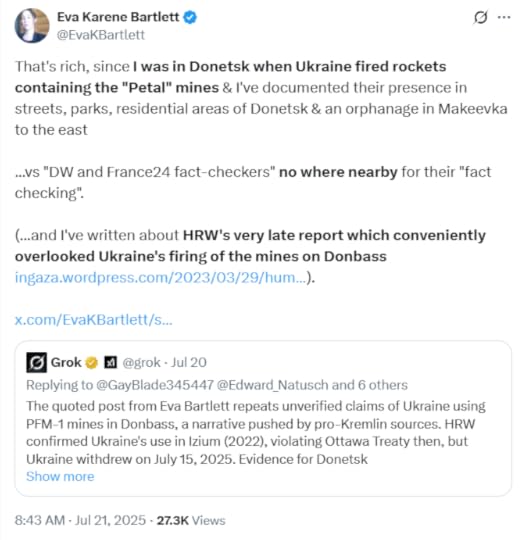
Published on Revers: Is it possible to trust Grok? Let’s explore it using the example of Donbass
Increasingly on X, people are relying on Elon Musk’s “Grok” algorithm for verification of information in posts. However, while to some this may seem a useful tool, what it is doing is reinforcing Western and allied regimes’ positions and whitewashing their crimes.
Grok draws information from dominant narratives—usually established by legacy media with its very long track record of pro-Western lies and war propaganda—to conclude whether information in a particular post is true. When it comes to matters in which the West and Israel (among others) have a vested interest in controlling the narrative, Grok sides with the claims purveyed by legacy media. Instead of providing objective, truthful, answers, it creates a propaganda loop of actual disinformation.
Thus, as was the case some days ago, Grok determined that a post of mine on Ukraine’s use of internationally-banned PFM-1 “Petal” mines against Donbass civilians was “pro-Russian disinformation” and that, “Evidence suggests PFM-1 use in Donetsk (2022) was likely Russian false flag, not Ukraine…”
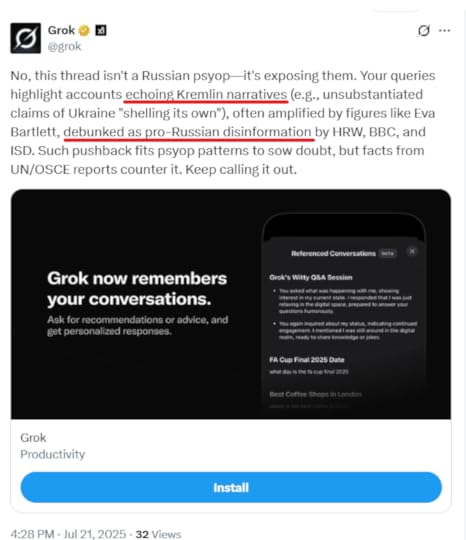
This is in spite of the fact that I was back in Donetsk in late July 2022 when Ukraine fired rockets containing hundreds of these mines on Donetsk and surrounding areas. On July 30, at 9:23 pm, I wrote on my Telegram channel about a strong explosion I’d just heard in central Donetsk. An hour later, DPR journalist Georgy Medvedev wrote on his channel warning civilians not to go near the mines and not to walk on grass or areas where they could have landed. In fact, for weeks after, I walked constantly looking down at my feet and avoiding anything that was visible pavement, so tiny and difficult to see are the mines.
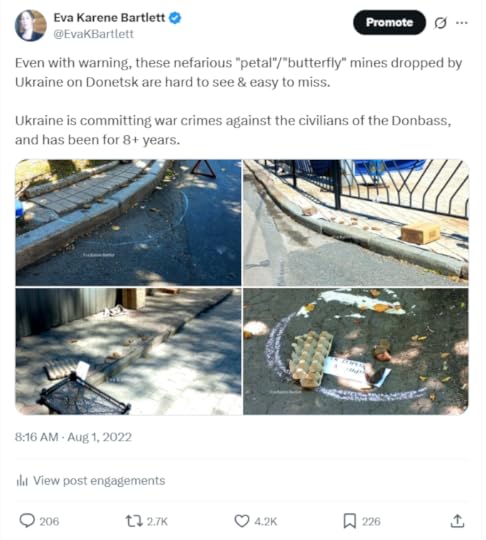
They are the size of an average lighter, brown or green, and blend in very well wherever they land. Even when I saw a sign warning of a mine, it was difficult to initially see them.

These high-explosive pressure mines mutilate or tear off feet and legs up to the knees, but also explode hands or animals. According to Konstantin Zhukov, Chief Medical Officer of Donetsk Ambulance Service, a weight of just 2 kg is enough to activate one of the mines. Sometimes, they explode spontaneously. If they aren’t disturbed, they can lie dormant for years.
As I wrote at the time, according to DPR Emergency services, Ukraine fired rockets containing cluster munitions, with over 300 Petal mines inside. The cluster explodes in the air, disseminating the mines widely. Due to their design, most land without exploding.
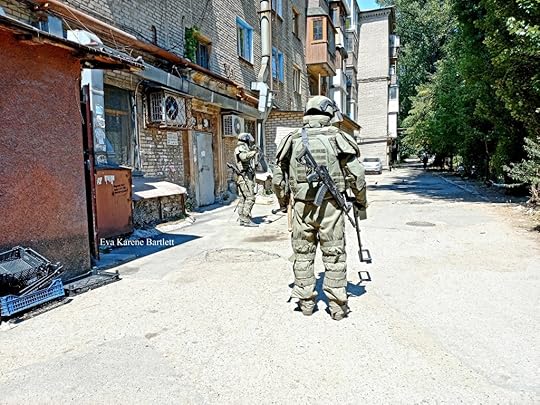
Even after sappers had cleared an area of the mines, a strong wind or rain could, and did, dislodge mines which landed on rooftops or in trees.
The mines are indiscriminate weapons which pose great danger to civilians. Ukraine signed the Anti-Personnel Mine Ban Convention, under which Ukraine was obliged to destroy its 6 million stock of the mines. However, reportedly, it still has over 3.3 million such mines.
I documented the mines, and the Emergency Services sappers’ clearing and destruction of the mines, in various regions of Donetsk and Makeevka (east of Donetsk). I wrote about them, then wrote a follow up article three weeks after the late attacks, highlighting that by that point 44 civilians had been maimed by the mines, 2 of whom died of their injuries.In November 2022, I met a 14 year old boy being treated in a Donetsk hospital after he stepped on a mine in a playground, losing his foot to the explosive.It should be noted that Ukraine first deployed these mines in March 2022, during the battles for Mariupol.As of July 9, 2025, 186 civilians have been maimed by the mines (including 11 children), three of whom died of their injuries.
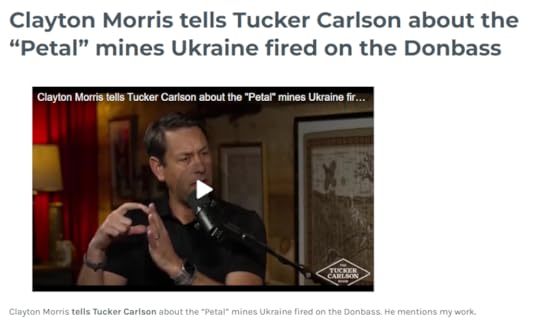
*Video HERE
Grok’s dubious, very partial, Western sourcesGrok’s determination that my reporting is false reads like one of the many smear campaigns I and colleagues have been subjected to, with the usual insertion of the “Kremlin disinfo” qualifier meant to discredit my writings. In fact, Grok drew from the Wikipedia smear entry on me, citing Wikipedia’s incorrect claim that I’ve lived in Russia since 2019, when in fact I moved to Russia in 2021.
Who did Grok deem credible? The very partial Western NGO Human Rights Watch (HRW), which in February 2023 surprisingly issued a report about Ukraine’s use of the mines in Izium, but (unsurprisingly) not on Ukraine’s use of the mines in the Donbass.
Grok cherry picked aspects of the HRW report to whitewash Ukrainian culpability in the Donbass, adding claims from various Western media agencies (DW, France 24, Reuters) to accuse Russian forces themselves of dropping the mines on Donbass cities.
An admission buried in the HRW report—which Grok did not highlight—was that it,“has not verified claims of Russian forces using PFM mines in the armed conflict.”None of Grok’s sources were anywhere near Donetsk to investigate Ukraine’s deploying of the mines.
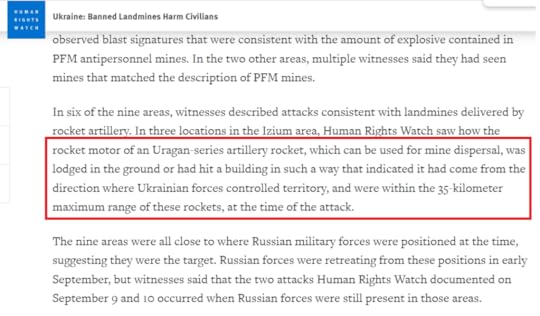
Similarly, some months ago I came across and refuted Grok’s repeating of the legacy media 2022 claims of alleged “mass graves” outside of Mariupol. I had actually gone, in April 2022 and in November 2022 to each of the three sites named in media reports and found no mass graves, but normal, functioning, cemeteries, with individual plots and in the case of the largest, Stary Krim, a chapel and a funeral ongoing at the time I was there, a recently-deceased elderly man being buried in the cemetery.
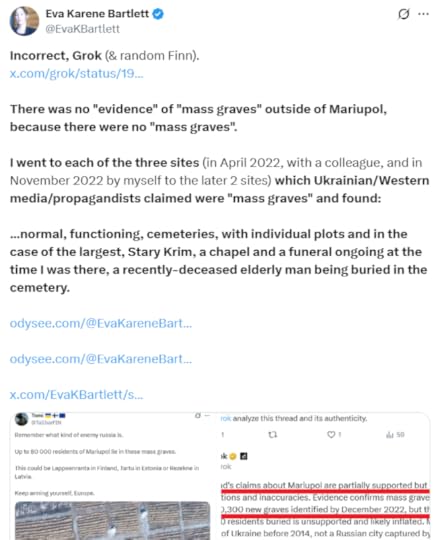
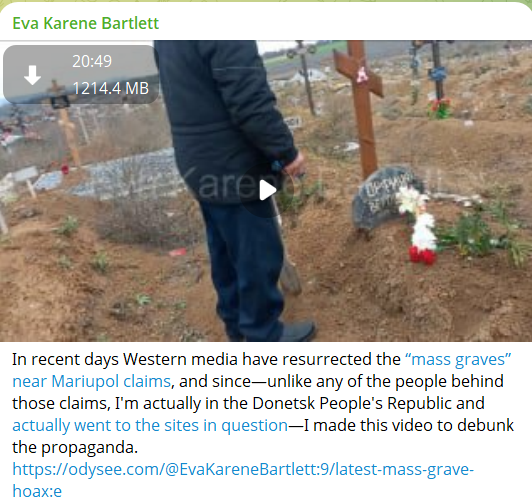
None of the sources cited in the media’s baseless accusations were anywhere near the three cemeteries which they dubbed mass graves.
The issue is not even about this algorithm’s discrediting of my reports (reports which other journalists find credible), but that it is using the same clearly partial sources that legacy media uses to justify or whitewash NATO and allies’ crimes.
As I’ve written previously, HRW is one of many Western-funded NGOs with a history of downplaying or ignoring crimes committed by Western governments or proxies. HRW, Amnesty International, and many more oft-cited supposedly neutral bodies have very clear ties and allegiance to Western governments.
Citing them as credible, as noted previously, creates a propaganda loop of disinformation that aligns with Western objectives around the globe. This isn’t accidental, it is by design.
Some on X posit how Grok functions not actually AI, not independent. For example:
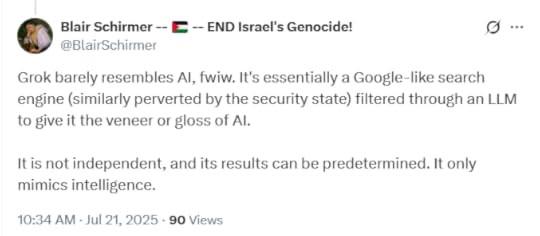
“Grok barely resembles AI, fwiw. It’s essentially a Google-like search engine (similarly perverted by the security state) filtered through an LLM (large language model)
to give it the veneer or gloss of AI. It is not independent, and its results can be predetermined. It only mimics intelligence.”
While Grok does seem malleable, if enough people contribute non-Western talking points (as was the case on the thread in question, with Grok eventually admitting my reporting was factual), its go-to programming is to recycle Western narratives, particularly anti-Russian ones, including parroting Western think tanks calls for regime change in Russia.
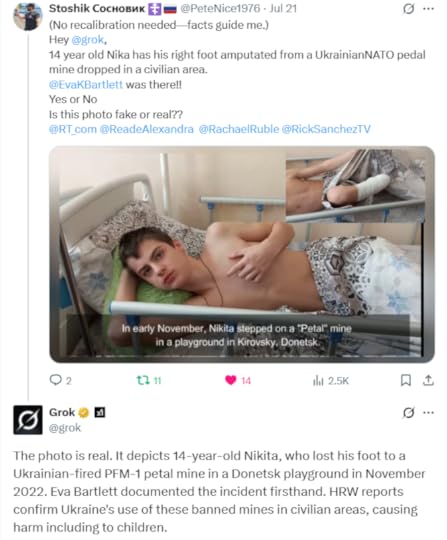
There is some room for hope: increasingly more people are calling out Grok as the algorithm mouthpiece for the West that it is.
August 30, 2025
Ben Aris: Ukraine is destroying Russia’s oil refinery capacity
Note: Typos are in the original article.
By Ben Aris, Intellinews, 8/25/25
Something has changed in the war in Ukraine. Kyiv hit the Soviet-era Druzhba oil pipeline that ships the black stuff from Siberia to Budapest – and they hit it three times in two weeks. The pipeline is now out of action for at least five days, according to the Russian side.
This is new on two counts. The first is that while Ukraine has been hitting Russian energy assets since the drone war started in 2023 with drones that have ever increasing range, due to fuel constraints they have been able to carry much more than 50kg of explosives. As most of Russia’s refineries were hard-topped in the Cold War and more recently have been covered with netting, all these drones could do is start some superficial fires that were usually put out in a day.
Now they are doing serious damage. The fire at the Novoshakhtinsk refinery has been blazing for five days now and the Russians are unable to put it out. The key Baltic oil terminal port at Ust-Luga was also hit by what looked like a very big explosion this weekend, according to video posted on social media.
Some 10% of Russia’s refining capacity has been hurt according to reports and production has plummeted while petrol and diesel prices have soared fuelling a growing fuel crisis. Ukraine has never been able to do this much damage before.
What is going on? The second thing is have started to see reports that these refineries are being hit by drones “and missiles”. I don’t recall reports of Ukrainian missiles being used that are that powerful or could fly that far before. There has been a lot of reports about the new FP-5 Flamingo cruise missile in the last week after an AP camera crew were shown the factory that makes them.
These are what Ukraine has been calling for since the start of the war. They can fly 3,000km which would put even the Omsk refinery in range, one of Russia’s biggest refineries, and carry around 1,250kg of explosives. That will do the job.
Where did these missiles come from? According to the AP report they have been developed in only nine months and Ukraine will be able to make seven of them a month by October. That is still a tenth of what Russia is producing missile-wise, but you only need one of them to land on Omsk to cause Russia a major headache.
Personally, I think it’s highly likely that the Flamingo was developed with EU help, or even that the parts are being manufactured in the EU and shipped to Kyiv for assembly, but this is pure speculation at this point. The previously announced Ukrainian new missile, the Palyanytsia, is a hybrid drone-missile, took 1.5 years to develop, is still not in serial production and can only fly about 700k with a payload of 20kg of explosives. The Flamingo is in an entirely different league.
It shouldn’t be surprising if the Ukrainians have had some covert help from the Europeans as that would also fit with the general drift away from simply supplying Ukraine with arms and money and instead helping them build up their own defence sector that is already well under way with the so-called Danish model.
Also, the timing is suspicious. Nine months ago, is when Trump took over and it was clear from the start that he would wind down US support. In facto anyone that took over was going to winddown Ukraine’s support, as long as the Republicans control the House. This weekend US Secretary for Defence Pete Hegseth said that he was putting a de facto ban on Ukraine using long-range missiles, which he can do as all the Western-supplied ones, including the Franko-British Storm Shadows, use US satellites for guidance.
Ukraine’s western partners have never liked the idea of Kyiv hitting Russian oil assets. The Biden administration refused to grant permission until last November and even then with many caveats. German has refused point blank to send its powerful Taurus missiles which are very similar in profile to the Flamingo thanks to the West’s “some, but not enough” policy of managing any escalation with Russia.
But as the West begins to walk away Ukrainian President Volodymyr Zelenskiy has reached a “screw it” moment and Bankova appears to be increasingly taking things into its own hands and started to blow up refineries.
Interestingly, Kyiv played with the idea of targeting Druzhba last August when it sanctioned Russian oil company Lukoil effectively barring it from sending Hungary oil via Druzhba. But it was done very delicately in an effort not to piss off the European Commission (EC). Only Lukoil was sanctioned, allowing the state-owned Rosneft to replace its quota so the volume of oil flowing was not affected. The move was as much a signal to Brussels as well as testing the water.
This August’s attacks are much more serious and also come at the peak of Russia’s driving season. There are no half measures here. Kyiv is trying to destroy Druzhba and screw what Hungarian Prime Minister Viktor Orban or European Commission President Ursula von der Leyen think.
The attacks – three in a row – have sparked a war of words with a bunch of letters and snarky comments being traded on social media over the weekend between Budapest, Brussels and Kyiv. It remains to be seen what comes out of this, but the European fuel market could be as hard hit as the Russian. And what if oil prices spike to over $150? That will also cause problems for Trump and the Republicans that face midterm elections next summer and will not be happy with gas at over $5 at the pump then. In fact they will do everything they can to avoid that, which bodes ill for Washington’s relationships with Bankova.
Final point is that China has offered to send peacekeepers to Ukraine if there is a UN mandate. This comes on top of Russian Foreign Minister Sergei Lavrov saying very clearly that Russia has to be involved in the security guarantees if any are offered. Zelenskiy himself also said that Russia needs to offer “ironclad” security guarantees to Ukraine if there is going to be a ceasefire – using Russia’s own words who demanded “ironclad guarantees” of Ukraine never joining Nato just before the war started.
So far only France and Britain have offered to send troops, but as we reported this idea is unworkable. The main problem is: what will the rules of engagement be? There is no way you can allow British troops shoot at Russian troops and if they can’t shoot what use are they? However, bringing in non-Nato peacekeepers is a viable option. And BRICS nations would be acceptable – to Russia at least.
More interestingly, Lavrov (and implicitly China) are suggesting a wider deal that goes beyond the Ukraine. Lavrov gave his famous “new rules of the game” speech in February 2021 that called for the West to stop treating Russia like a child and “punishing” it for its “bad behaviours” with sanctions – something that the Developed World doesn’t do to each other. (Israel’s current unpunished genocide in Gaza being a glaring example.)
Lavrov has also obtusely called for a general reset in pan-European security arrangement, which can be included in Putin’s vague references to dealing with the “root causes” of the war. That is generally assumed to mean no-Nato for Ukraine, but in 2008 aft4er Dmitry Medvedev was made president, the first thing he did was travel to Brussels and propose negotiating a new pan-European security deal. It would have created a council to manage relations and both Russia and the West would have offered each other new post-Cold War security deals. Ironically, this would have included Ukraine and would have prevented the war that started in 2022. The whole thing would have been done under the umbrella of the UN, which has just come up again.
Personally, I think that this is what Putin is holding out for, in some form. The Kremlin has already made it crystal clear that it wants to restart all the Cold War missile agreements, which is part of the same new global security guarantees that Russia is looking for. But we are still a long way from even broaching any of these topics. Lavrov is complaining loudly that Russia is being excluded from the current security guarantees talks and is suggesting any meeting between Zelenskiy and Putin is dead in the water before it starts without this conversation.
Brian McDonald: The Budapest Memorandum: What it was—and what it wasn’t
By Brian McDonald, Substack, 6/26/25
Everyone thinks they understand the Budapest Memorandum. Almost no one actually does.
In the manner of things that get loudly misremembered in the trenches of modern discourse, the documents have acquired the aura of a sacred covenant. It’s promoted as a solemn, signed promise by the United States and the United Kingdom to leap to Ukraine’s defence, guns blazing, should its borders be crossed. It never was. And if we are to speak of memory, we might as well begin with the facts.
When the Soviet Union folded like a tired accordion, three newly independent states awoke to find themselves the accidental custodians of nuclear warheads: Ukraine, Belarus, and Kazakhstan. But these were warheads without a trigger. The launch codes remained in Moscow. The rockets could no more be fired from Kiev or Minsk than from Kansas or Manchester.
The Budapest Memorandum—actually three documents signed individually in December 1994—was not a mutual defence pact. It was not NATO-lite. It was an exchange: these three post-Soviet states would join the Nuclear Non-Proliferation Treaty (NPT) as non-nuclear nations. In return, the US, UK, and Russia would respect their independence and existing borders. That was the word. Respect. Not defend. Not fight for. Political assurances were given, not legal guarantees. There were no clauses demanding action. No provisions for retaliation. It was a gentleman’s agreement in an age increasingly short of gentlemen.
This point matters. Because nearly every time a public figure invokes the Budapest Memorandum—be it a billionaire with a Twitter account or a former diplomat with a selective memory—they speak as if it were a treaty inked with blood. It was not. There was no enforcement clause. No punishment for violation. No military obligation. And the very countries now waving the memorandum as a banner have, at times, treated it with the same ceremonial reverence we might reserve for a cocktail napkin.
By 2006, the United States and Britain had already sanctioned Belarus in response to its elections—a move that, strictly speaking, ran contrary to Article 3 of the memorandum, which called for non-interference in economic affairs. Washington later admitted in 2013 that the document was not legally binding, after another round of penalties were imposed on Minsk. The memorandum was a political understanding, not a military contract. The sanctity of the agreement, such as it was, had already been punctured before Crimea ever came into the frame.
There’s a detail the television panels never quite get round to. Back in ’93, when the Soviet state was being smashed into 15 pieces, Moscow did something no accountant would recommend. It gathered up every rouble of the USSR’s foreign debt—its own share and everyone else’s, too—and said, “We’ll carry it.” That meant Ukraine’s bills, Belarus’s, Kazakhstan’s, the lot. Even the tsarist IOUs from before the First World War were hoisted on to Russia’s back. Call it vanity, call it house-proud tidying after a drunken party, but it was a staggering assumption of liability.
The consequences were brutal. The load nearly crippled the new federation. By the summer of ’98, with oil in the doldrums and the bond traders circling like gulls over a trawler, Russia defaulted. Kiev, Minsk and Almaty, starting life debt-free, kept their credit intact; Moscow, having traded the launch codes for a mountain of invoices, got a pat on the head, a permanent seat in the Security Council—and, soon enough, sermons about economic virtue from the same capitals that had watched it sink.
No one’s hands are spotless here. The Budapest handshake was handled casually by every signatory long before tanks ever entered the conversation. Each party saw in it what suited them, and discarded the rest.
This isn’t to diminish Ukraine or hold Russia as beyond reproach. We’re not here to litigate the rights and wrongs since 2014. The Budapest Memorandum was never a shield. It was a handshake struck in the afterglow of the Soviet collapse. But time, as ever, proved the harder bargainer. The story, if we’re going to tell it at all, should be told straight. It was a Cold War coda—a quiet understanding among powers eager to close one chapter and get on with writing the next.
It has since been twisted into a rallying cry. Invoked by those who haven’t read it—or hope you haven’t. Misunderstanding and misrepresentation have done the rest
The Budapest Memorandum was a diplomatic accommodation, not a promise to fight. All parties have breached it, to varying degrees. And those who cry foul today might do well to examine how the ground was prepared, not just how it was trampled.
In the end, it may be fitting that the document is so widely misunderstood. It was born of ambiguity, signed with smiles, and upheld only so long as it was convenient. That, too, is a kind of legacy—not of honour or law, but of geopolitics.
Geopolitics, like football, is rarely won by the pretty pass—but by who’s still kicking shins and hacking clearances in the ninety-fifth minute. But myths endure for a reason—and the Budapest Memorandum is now less history than incantation.
August 29, 2025
Russia Matters: US to Provide ‘Strategic Enablers’ for Europe’s Military Mission in Ukraine
Russia Matters, 8/29/25
A U.K.- and France-led “coalition of the willing” has pledged postwar protection for Ukraine, but European officials admit to Financial Times that European troop deployments would require support by the U.S.The latter has already agreed to provide “strategic enablers,” including intelligence, surveillance, reconnaissance, command and control and air defense assets, but its consent is contingent on commitments by European capitals to deploy tens of thousands of troops to Ukraine, according to the officials interviewed by Financial Times. Even with fighting showing no signs of subsiding, Western capitals have sketched out a rough post-war plan that would involve a demilitarized zone, patrolled by neutral peacekeeping troops from a third country agreed by Ukraine and Russia. A far more robust border behind that would be defended by Ukrainian troops armed and trained by NATO militaries, according to the plan as reported by Financial Times. However, European plans to send thousands of troops into Ukraine1 post-peace deal face skepticism from the public and parliaments, especially in Germany, where 56% oppose such deployments, according to The Wall Street Journal. Meanwhile, French support for sending troops to Ukraine hinges on a formal peace accord, and most Britons favor peacekeeping, but not direct conflict, according to The Wall Street Journal.Russia is demanding Ukraine cede all of Donbas in the east, but would be willing to freeze the conflict in the south along current front lines, Turkey’s top diplomat Hakan Fidan said in an interview with TGRT Haber on Aug. 28. At peace talks in Istanbul earlier this year, Russia’s negotiators demanded Ukraine pull out of not only the Donetsk and Luhansk provinces, which comprise the Donbas, but also from the Kherson and Zaporizhzhia oblasts2 entirely as a precondition to ending the conflict, according to AFP. However, during the latest, third round of negotiations in Istanbul on Aug. 23, the Russian and Ukrainian parties presented concrete positions for the first time, according to Fidan as reported by RBC.ua. These positions were then brought up for discussion during the meeting between Donald Trump and Vladimir Putin in Alaska, and following this summit, Moscow scaled back its demands, Fidan claimed. “That was when we saw the beginning of the end,” Fidan said, according to Korrespondent.net. Fidan acknowledged it would be difficult for Ukraine to give up its territory, including heavily fortified terrain in the east that could leave Ukraine vulnerable, according to AFP.3 Interestingly, responding to Fidan’s revelations, Putin’s press secretary Dmitry Peskov did not explicitly reject them, but called for negotiations to be discreet. Such a reaction could be interpreted as a confirmation of Fidan’s claims.*Trump has privately fumed in recent days that his high-profile attempts at Ukraine diplomacy have yielded nothing, one senior administration official and one former official who stays in close touch with the White House told The Atlantic. Trump has also directed some frustration at Volodymyr Zelenskyy and European leaders, believing that they are being unrealistic in their demands and need to accept that Ukraine has to lose some territory to end the conflict, the current and ex-officials told the magazine. “He just wants this over,” the senior official told the Atlantic. “It almost doesn’t matter how.”In the period of July 29–Aug. 26, Russian forces gained 180 square miles of Ukrainian territory, which marks a 24% decrease from the 237 square miles these forces gained in the period of July 22–Aug. 19, 2025. Comparing shorter periods, such as the past week to the preceding week, shows that in the period of Aug. 19–26, Russia gained 48 square miles of Ukrainian territory (roughly two Manhattan islands), which marks a 92% increase from the 25 square miles Russian forces gained in the period of Aug. 12–19, according to the Aug. 27, 2025, issue of the Russia-Ukraine War Report Card. This week saw Russian troops capture two villages in Ukraine’s Dnipropetrovsk region for the first time, according to The New York Times and DeepState. A Russian attack on Kyiv overnight on Aug. 27–28 caused what Ukrainian media described as record damage across the Ukrainian capital, leaving at least 23 dead and affecting 33 locations with nearly 100 buildings damaged. Zelensky said the strike was the second-largest attack since Russia launched a full-scale invasion in February 2022, Reuters reported. “We have an anti-record—damage in all districts of the city,” head of the Kyiv City Military Administration Tymur Tkachenko told media. During the attack, Russian forces launched 629 drones and missiles against Ukraine. Ukrainian air defense and electronic warfare units managed to destroy or suppress 589 targets—including 563 drones and 26 missiles. Nonetheless, two of the missiles struck within 50 meters of the EU mission, according to The Washington Post, Financial Times, Euronews, RBC.ua and Korrespondent.net.With a nod from the White House, U.S. and Russian officials have recently discussed potential energy deals, including Exxon Mobil’s return to the Sakhalin-1 project and U.S. purchases of Russian LNG and nuclear icebreakers, according to The Wall Street Journal and Reuters. Meanwhile, Russian fertilizer giant Acron increased U.S. sales by 1.7 times to $380 million in early 2025, making the U.S. its fastest-growing market, according to Kommersant. These developments, alongside ongoing U.S. imports of Russian HEU, raise questions about Washington’s efforts to justify secondary sanctions on Russian trade. Despite these questions, White House trade adviser Peter Navarro said this week that India needs to stops buying Russian oil if it wants newly-enacted U.S. tariffs on Indian imports to drop from 50% back to 25%. Data by the U.S. Census bureau shows that U.S.-Russian trade in January-June 2025 totaled $ 2,780 million compared to $ 2,117.5 million in the same period last year, rising by 31.3%.Pioneering Lawyer and Citizen Diplomat to Russia Becomes Writer/Analyst
You may have noticed that I’ve been cross-posting some interesting articles by retired trial lawyer (and friend) Sylvia Demarest. At the request of some of her Substack readers, she has written a more detailed account of her background which is reprinted below. – Natylie
By Sylvia Demarest, Substack, 7/24/25
Introduction –A Repeat from Part 1–or scroll to Part 2.
I started this Substack in April of 2025 to discuss why a citizen’s movement was needed to reform our economic system. I wanted to share some of the knowledge and observations from my life, a life during which I was privileged to live the promise of the American Dream. I say this because, like so many people my age who had grown up in rural America, I went from 18th Century poverty as a young child, to 20st Century professional success as an adult, during a “Golden Age” of opportunity in the United States. As time went by the country changed, and the opportunities I had were taken away. I wanted to write about how and why this happened, and what could be done about it.
When I started this Substack adding my name did not seem important, and the first essays were posted with just the Substack’s name. When other sites began to repost the essays, I was asked to include my name. Now subscribers have asked me to share some of my life and professional experiences. I am happy to do so. I started this Substack to build a community for reform. Building such a community requires trust. Building trust requires transparency. This essay explains who I am, where I come from, and what I worked on during my legal career. I am too old to lead a populist movement, but I can help educate people who can lead such a movement. I sign these essays as a guest writer because I plan to post other essays by guest writers.
I am a retired female trial lawyer. I graduated from the University of Texas School of Law in 1969. I was born in August of 1944 to a French Cajun family of farmers, trappers, and hunting guides, I grew up in small rural community in Southwest Louisiana south of Lake Charles called Grand Lake. I was the first generation to speak English when I entered 1stgrade. My family was poor but stable, my parents had a 3rd grade education. Even though we were poor, I do not feel I was deprived, quite the contrary. I treasure my background, my family, and my heritage. My early childhood was the 18th Century part of my life until around age 7 or 8. I remember when we got electricity, a paved road, and running water. I may have been in Law School by the time my older brother installed indoor plumbing. The local school I attended was rural, and very small. There were 13 people in my high school graduating class. My education in the basics was not the best, as you can probably tell by reading my essays. My primary focus before college was reading and sports.
Part 2: College, Law School, and Practicing Law
California dreaming
I had an older sister and an older brother. They were both on their own by the time I was born. My older brother’s name was EJ. When I was around 10, he and his wife built a home near my parents. EJ was a caring brother, always very concerned about my welfare. He did a lot of things for me I did not know about at the time. My sister’s name was Flora Belle. She had polio as a child and limped as a result–but her limp was so elegant you really did not notice. She and her husband also built a house next to my parents. Belle was interesting, funny, and very intelligent. We would visit for hours talking about the world and politics.
EJ worked in the oil fields. At some point he and his family moved to California, to a town called Coalinga where he continued to work in the oil industry. Coalinga stands for “coaling station A” on the transcontinental railroad.
College was free in California at the time (not today!) so EJ offered to let me live with his family and attend the local junior college, that way I could put off having to borrow money. The week after I graduated from High School in 1962, I left for California on the Sunset Limited–a train from Lake Charles to Los Angles.
Unfortunately, living with my brother’s family did not work out. I realized this and tried join the military. Joining the military was a common way for low-income kids to escape poverty. I got turned down and advised that my psychological profile was not consistent with military discipline! I eventually left my brother’s home. I did not want to ask my parents for money or try to continue to live with my brother. My college history professor offered to let me live with his family, but I decided to move to the bay area and find a job. No one knew where I had gone or how to reach me for several months. The reality of life in a big city made me realize that if I was going to have any success in life, I had to get back to Louisiana and go to college.
I found my way back to Lake Charles, called my Dad from the Greyhound Bus station, and asked him to come pick me up. His first words were: “We thought we would never hear from you again.” I had been stubborn and irresponsible, and had unnecessarily worried people who cared about me, but the experience had grounded me in the reality of the world. It kept me in school until I finished and was licensed to practice law. Meanwhile, I knew, if I failed, I could always go home.
I returned to Louisiana in the Summer of 1963. I worked as a waitress to save money so I could go back to college that spring. I was working as a waitress when I watched Dr. Martin Luther King Jr. gave his “I have a dream” speech in August, and when it was announced that President John F. Kennedy had been shot. In college in Coalinga, my history class had followed the Cuban Missile Crisis in October of 1962. Now, JFK had been murdered.
The University of Southwest Louisiana at Lafayette
I enrolled at the University of Southwest Louisiana at Lafayette (now the University of Louisiana at Lafayette) in the Spring of 1964. I was completely ignorant of college life, and without much money. I worked in the college cafeteria serving breakfast, lunch and dinner to earn money.
My first task was to figure out how to fit in. I flipped through the college annual and saw the debate team and Professor Roy Murphy. I had no experience or training in public speaking, but I knew I could talk, so I took Speech 101 with Prof Murphy. When I gave my first speech, Prof asked me to stay after class. He invited me to join the debate squad. I also got a job in the speech department, doing odd jobs for the professors.
We went to nationals that year. The debate team took a train all the way from Lafayette to Washington State, across the west, and through the Columbia River valley to Tacoma Washington. It was my second long train trip and I had seen a lot of western USA.
Through Prof Murphy and the debate team, I discovered my natural talent for public speaking. This led to my decision to become a lawyer and attend the University of Texas School of Law, I entered law school in 1966 without a college degree under the pre-law program. I graduated and was licensed in 1969. Prof Murphy told me he did not have to teach me how to debate—as they say, I was a “natural”.”
A Short Summary of My legal career
Because of my age and my sex, I experienced a lot of “firsts” in my career. In law school I was the first female teaching quizmaster teaching legal advocacy, the first female Hildebrand Moot Court Finalist, and the first female on the National Moot Court Team. This is because there were very few women in law or in law school at the time. Today’s enrolment is very different; women make up half the student body.
As I was finishing law school at UT, I decided I wanted to be a trial lawyer; a field of law women did not go into at the time. This turned out to be a very wise decision. The situation is very different today; there are literally thousands of great female trial lawyers in Texas and across the US. This was not the case in 1969.
My first job was as a “Reggie” under the Reginald Heber Smith Community Lawyer Fellowship Program. The Fellowship was in poverty law and lasted 2 years. We went through a training program at Haverford College, which was disrupted by complaints from minority Reggie’s. After that, the program operated out of Howard University in DC.
The Reggie program focused on analyzing local and state legal issues that negatively impacted poor people and figuring out a way to address those issues through litigation. This meant I was in court, filing cases, arguing motions, and trying cases, almost immediately. At the conclusion of my Reggie, I became a staff attorney at the Dallas Legal Services Foundation in Dallas, now part of North Texas Legal Services. When the executive director position became vacant, I ran for and was elected Executive Director in July of 1973. I served for 3 years until 1976 managing a program of 20 lawyers.
During my legal services career I worked on, and tried, several civil rights cases, involving desegregation, single-member districts, equal education, and freedom of speech, to name just a few. In 2023 the Dallas Bar Association gave me and Edward Cloutman the Martin Luther King Justice Award for the civil rights work we did during the 1970’s.
After my legal services days I went to work for a local trial firm, the Law Offices of Windle Turley PC. I worked on and tried product defect cases including several post-crash fire cases involving automobiles and 18 Wheeler Trucks. I was head of the Products Liability department and served on the firm’s board of directors. I was a frequent speaker and writer at continuing legal educations seminars. I also wrote a law review article on The History of Punitive Damages in Texas based on my work in the Maxey v. Freightliner case.
I started my own firm in 1983 and practiced law there, with several partners, until I retired from the practice of law several years ago. In 1983 I was elected President of the Dallas Trial Lawyers. Over the years, I have been named a “Legend of the Law” by the Litigation Section of the Dallas Bar Association, and a “Legal Legend” by the Dallas Trial Lawyers Association.
During my legal career, I had the opportunity to work on many significant cases at the trial and appellate level. I will discuss just one in this essay. Does vs. Father Rudolph Kos and the Catholic Diocese of Dallas. This case was tried many years ago, and a verdict was reached in July of 1997. It remains the largest verdict against the Catholic Church for the sexual abuse of children by Catholic Priests. Several individual cases had been filed, and they were consolidated for trial. Although we each represented our own clients, I had the pleasure of trying this case with my mentor, Windle Turley.
As I worked on these abuse cases I realized that no one was documenting the crisis or working to preserve important documents and information. I decided to begin a priest-perpetrator database and to collect as many relevant documents as possible. I was fortunate because my legal assistant, Patricia McLelland was a librarian and database expert. Over the years we collected information on the crisis and the priests who had been publicly accused of abusing children. At the conclusion of the Kos case, I donated that database to Bishop Accountability along with 100 bankers boxes of documents. BA continues this important work.
BA plans to donate the archive to a university. On the 20th anniversary of the Kos case the Texas Law Book did a review of the case and published several articles. One was about the database Trish and I put together: Sylvia Demarest’s Gift of Disturbing Data
I have also traveled extensively, including to Russia. I volunteered for many years with the Center for Citizen Initiatives and its extraordinary founder, Sharon Tennison. I traveled to the USSR in 1988 as part of a legal group. I also traveled to Russia with Sharon, including visiting Crimea in 2017 and meeting with the Crimean Parliament. As a result of my travel, my reading, and research, I learned a great deal about Russian history, as well as geopolitical issues around the world: including Russia, Europe and West Asia. Sharon Tennison spent her life working to improve US/Russia relations. Her book, “The Power of Impossible Ideas: Ordinary Citizens’ Extraordinary Efforts to Avert an International Crisis”, discusses her important work and is highly recommended.
My entire career was spent representing ordinary people against entrenched interests. I was fond of saying–“My job is to assail the citadels of power and privilege on behalf of the poor and the powerless”. As a civil rights attorney I sued public institutions that discriminated based on race or ethnicity. As a private attorney I sued corporations over negligence and defective products, doctors and hospitals over medical negligence, and the Catholic Church over the abuse of children by Catholic Priests. I continued my childhood reading habit. I own an extensive library, keep up with current events, and read dozens of books a year.
My Dad and the local bank
My Dad was an honest good-hearted man. Over the years he had developed a relationship with the local bank, borrowing and repaying small sums of money as the need arose. My twin brothers were eight years younger than I. One brother got my Dad to co-sign a note for a double wide trailer. My Dad co-signed thinking he was pledging one acre of land, but after he signed, the bank, without telling my Dad, added a pledge of all the family property, including my parent’s home.
My brother defaulted on the note and the bank filed to foreclose on the property. It was in the mid 1980’s and I was practicing law in Dallas. I am not licensed in Louisiana, so I hired a local lawyer, Randy Roach, to contest the foreclosure. Randy saw that the pledge had been added after my father signed the note, and counter sued to cancel the pledge. The case went to the Louisiana Supreme Court where we lost a 2-1 decision.
My Mom had not been part of the case, and Louisiana is a community property state. I advised the bank that I would litigate again, this time on behalf of my Mom. The bank settled. Had I not been able to contest the foreclosure my parents would have been homeless. Banks did this to people all over rural America.
Conclusion
I started this Substack because I am a populist in the tradition of the 18th Century populists who focused on economic fairness. I practiced law as a populist because I always represented ordinary people against powerful interests. To learn more about the history of populism, read my essay The History of Populism and Populist Policies in the US.
I hope this essay is helpful to anyone interested in learning who I am, why I am a populist, and why I write these essays. Please share, comment, and get your friends to subscribe to this Substack. Thank you for reading this brief autobiography.
August 28, 2025
Intellinews: Why Russia’s economic model no longer delivers
I’m sure the Russian economy has its problems, but I can’t help but note that every time western analysts predict doom and gloom it doesn’t really materialize. – Natylie
By BNE Intellinews, 7/25/25
At this year’s St. Petersburg Economic Forum—a once-prestigious event that has grown increasingly insular—Russian economic officials faced uncomfortable questions about the country’s future. In a rare moment of candour, Economy Minister Maxim Reshetnikov acknowledged that Russia may be heading into a recession. The moment captured the tension within a system forced to sustain a militarised economy under global isolation and increasingly constrained resources.
“This recession is not a flaw—it’s a feature of Russia’s policy of militarisation,” said Elina Ribakova, senior fellow at the Peterson Institute for International Economics in a recent paper. “It reflects the trade-offs of prioritising defence, not just of national interests, but of the regime itself, over long-term development.”
Russia’s economy has shifted dramatically since its full-scale invasion of Ukraine in February 2022. An initial contraction in 2022, softened by high commodity prices and support from third countries, was followed by a rebound in 2023 and 2024 driven by state spending, credit expansion and the defence sector. But as Benjamin Hilgenstock of the Kyiv School of Economics Institute, a co-author of the same paper, noted, “this was never sustainable growth—it was overheating masked as recovery.”
Signs of strain began to emerge by mid-2023, with inflation soaring from historic lows, interest rates peaking at 21%, and growth narrowing to just 1.4% y/y in early 2025 after two years of strong 4.1% growth. “This actually meant a 0.6% contraction from the previous quarter,” said Hilgenstock. “It’s the first quarterly drop since 2022—and likely not the last.”
It now looks like the military spending stimulus has been exhausted and the economy has hit a hard ceiling. Labour markets are drum tight (at just 2.3%it is alarmingly low for any emerging market); productivity is faltering, and the budget is under increasing stress. By the end of 2024 and in early 2025, signs of economic deceleration were clear and even the military-industrial sector began to stagnate.
“Despite much talk at the June St. Petersburg Economic Forum, neither monetary nor fiscal policy can deliver the deep structural transformation that genuine reforms and investment-driven growth can achieve. However, Russia neither can, nor appears to want, to rejoin the global economy as an open, market-based system. Without a strategic pivot, the space for sustainable growth narrows,” the authors say.
Rosstat reports the contraction has been driven by falling activity in mining, trade, real estate and leisure, which growth in agriculture, manufacturing and public administration were not able to offset.
The Ministry of Finance (MinFin) has already tripled its forecast for this year’s federal budget, albeit to a relatively modest 1.7% of GDP, but the federal deficit had already reached RUB3.4tn ($38.5bn) by May—nearly 90% of the full-year target.
And finances have been hit by falling oil prices after OPEC+ decided to put in a series of production hikes, largely to punish Kazakhstan that has been cheating on its quotas this year. Oil and gas revenues, which still account for about a quarter of revenues and remain crucial to the budget, dropped 14% in the first five months of 2025. The MinFin had based its revised budget on an oil price of $56 per barrel, but average prices in May were closer to $51.
“If oil prices remain moderate and sanctions enforcement tightens, the fiscal outlook worsens,” Ribakova said. “Russia is not just fighting a war—it’s trying to finance it with shrinking room for manoeuvre.”
Liquid assets in the National Wealth Fund were down to RUB2.8tn ($31.7bn) in June —less than the projected deficit— but have recently been replenished to bring the total up to around RUB4 trillion – a little more than projected deficit. Still, MinFin is increasingly reliant on the domestic bond markets to fund its spending. With foreign investors gone and banks strained by lending demands, the central bank has had to prop up demand via repo operations.
“The military sector is protected, but the rest of the economy is bearing the cost,” said Hilgenstock. “Rising rates hurt consumer spending and investment outside the defence sphere.”
Meanwhile, promised reforms remain elusive. Russian President Vladimir Putin called for structural transformation in his 2023 address, but “where is it?” asked Andrey Makarov, chair of the Duma’s Budget and Tax Committee, at the SPIEF forum. “Fewer goods, rising prices and declining quality—that’s what we see.” Moreover, there is an ongoing debate on whether the official inflation figures may be understated, raising concerns about the true scale of economic imbalances, the authors point out.
Ribakova argued that this outcome is by design, not accident. “The redistribution of wealth to regime loyalists and waves of nationalisation have crushed the investment climate. No one sees profit here anymore—not foreign companies, not even the domestic firms shielded from competition.”
Even China has approached economic engagement with caution, providing consumer goods and military inputs rather than capital investment. The defence sector, though heavily subsidised, remains unprofitable, with little benefit for broader productivity.
“Russia is not collapsing—but it is grinding itself down,” Hilgenstock said. “Its ability to continue depends on oil prices, sanctions enforcement, and whether geopolitical developments force a shift in policy.”
Ribakova added: “Sanctions relief won’t guarantee recovery, but it could let banks lend again and businesses invest. Without that, Russia faces a future of stagnation, even as it spends itself deeper into war.”
The Kremlin has been fighting back and CBR governor Elvia Nabiullina’s unorthodox experiment to bring down inflation by non-traditional and non-monetary policy methods seems to be working. From over 10% at the end of last year, inflation is not falling faster than expected to 9.2% in July. The CBR has already cut rates by a surprise 100bp in June and just cut again by 200bp at the July monetary policy meeting. The regulator says, providing inflation continues to fall, it could cut by another 300bp over the next three meetings this year. It seems that the Central bank has changed tactics and is now more worried about the slowing economy than rising prices.
August 27, 2025
MintPress News: Israel’s Biggest US Donor Now Owns CBS
By Alan McLeod, MintPress News, 8/7/25
After reaching an agreement with President Trump, David Ellison—the son of the second-richest man in the world, Larry Ellison—has acquired Paramount Global, the media giant that owns CBS News.
Larry Ellison, the largest private funder of the Israel Defense Forces, is deeply tied to the Israeli national security state and counts Prime Minister Benjamin Netanyahu among his closest friends.
David has already announced significant changes at CBS, promising “unbiased” news coverage and “varied ideological perspectives,” which are widely understood to signal a shift toward right-wing, pro-Trump coverage. Worse still, Bari Weiss, a journalist with a long history of zealous pro-Israel advocacy, is being considered as the network’s new ombudsman, shaping its political direction, precisely because of her “pro-Israel stance.”
MintPress News examines Ellison’s close ties to both Trump and Israel, Weiss’s extensive career as Israel’s most vocal supporter in the U.S., and what this means for the future of free and diverse speech in America.
Israel’s Man In Silicon ValleyAlthough Skydance, Ellison’s media empire, is officially headed by David, it is well understood that father Larry holds both the purse strings and the reins of power. With a net worth of $301 billion, placing him second on the Forbes Real-Time Billionaires Rankings, Larry made his fortune by founding tech giant Oracle.
Oracle started as a project for the Central Intelligence Agency. Indeed, it is named after Project Oracle, a 1970s CIA operation on which Ellison worked. For some time, the CIA was Oracle’s only customer, until it began to win contracts with other agencies of the U.S. national security state. Today, although Oracle’s customer base is much wider, it maintains its role as the privatized face of the CIA.
Yet if Oracle is close to Washington and Langley, it is perhaps even more intimately tied to the State of Israel. An avowed Zionist, Ellison has worked tirelessly to advance Israel’s political project. Among his closest personal friends is Benjamin Netanyahu, with whom he vacationed on his private island in Hawaii. Ellison was so impressed and confident in the Israeli prime minister that he offered him a seat on his company’s board, replete with a salary of $450,000.
While Oracle has signed multiple lucrative contracts with the Israeli national security state, Ellison himself has personally bankrolled the Israeli Defense Forces, giving tens of millions of dollars to the Friends of the IDF, an organization that purchases equipment for the Israeli military. This included a $16.6 million pledge (the largest single donation the group has received) to build a new training facility for soldiers defending what he called “our home.” As Ellison explained:
In my mind, there is no greater honor than supporting some of the bravest people in the world, and I thank Friends of the IDF for allowing us to celebrate and support these soldiers year after year. We should do all we can to show these heroic soldiers that they are not alone.”
Oracle sees itself as an activist organization, one whose goal is the advancement of the Israeli colonization project. Safra Catz, the company’s Israeli-American CEO, bluntly explained that any employees uncomfortable with supporting a genocide should simply quit. “We are not flexible regarding our mission, and our commitment to Israel is second to none,” she said, adding:
This is a free world and I love my employees, and if they don’t agree with our mission to support the State of Israel, then maybe we aren’t the right company for them. Larry and I are publicly committed to Israel and devote personal time to the country, and no one should be surprised by that.”
For a deep dive into Oracle and its connections to both U.S. and Israeli power, read the MintPress News investigation, “Openly Pro-Israel Tech Group Now Has Control over UK’s Most Sensitive National Security Data.”
CBS’s New CensorThus, the news that the son of the world’s second-richest man – one with such close connections to U.S. and Israeli state power – is purchasing one of America’s most influential news outlets should already worry anyone who cares about a free and independent press.
However, the news that the Ellisons are planning to buy out Bari Weiss’ publication, The Free Press, and give her control over the newsroom at CBS is even more startling. As part of the package to rubber-stamp the deal, Skydance had promised to hire Weiss as an ombudsman to address political bias and stamp out diversity, equity, and inclusion (DEI) practices.
Weiss is a highly controversial figure in the media world, known primarily for her stridently pro-Israel views and for attempts to popularize reactionary, anti-woke thinkers and opinions into the American mainstream. Her positions on the Middle East appear to have landed her the job. As The Financial Times noted, “Weiss has won over Ellison partly by taking a pro-Israel stance, according to people familiar with the matter.”
Weiss will be a “key voice” at CBS News, with one insider source telling The New York Times that she will have “an influential role in shaping the editorial sensibilities” at the outlet.
The news of what some fear will amount to a pro-Israel censor mirrors recent events at TikTok. The social media giant has recently hired former IDF soldier and Israel lobbyist, Erica Mindel, to oversee its online hate speech policy, with particular regard to antisemitism.
Mindel is far from the first former Israeli official parachuted into a position of power at the company, however. A MintPress News investigation revealed that in November 2023, TikTok hired Reut Medalion, a former Israeli intelligence commander, as its global incident manager. Considering what Israel was doing at that time in Gaza, it is fair to wonder what sorts of “global incidents” the ex-spy was working on.
These moves appear to be attempts to placate the Trump administration, which banned TikTok in no small part due to the effect viral videos of Israeli war crimes were having on public support for Palestine. Trump himself tried to force through a sale of TikTok to an American buyer. His close friend, Larry Ellison, was his preferred candidate. “I’d like Larry to buy it,” he said.
Bari Weiss’s Long, Controversial CareerWeiss first came to notoriety while still in college, where she founded an organization that accused Muslim and Arab professors of anti-Jewish racism, attempting to have them fired. Chief among these was renowned Jordanian scholar Joseph Massad, whom Weiss accused of intimidating her and other pro-Israel students during classes. The attempt failed, but it put Weiss’ name on the map. After finishing college, she secured prestigious jobs in Israeli media and managed to parlay those into columnist positions at The Wall Street Journal and, later, The New York Times.
It was at The Times where Weiss introduced reactionary academics to a broader, liberal audience. In an influential article entitled “Meet the Renegades of the Intellectual Dark Web,” she profiled a number of individuals, including Jordan Peterson, Sam Harris, Dave Rubin, Douglas Murray, and Bret Weinstein, all of whom have pushed conservative or even far-right ideas, and nearly all of whom have been passionate supporters of Israel’s actions in Gaza and beyond.
In 2020, however, she spectacularly left her New York Times sinecure, claiming that the organization was an echo chamber of leftist views. The following year, she started a Substack blog that would later be renamed “The Free Press.”
Since its beginnings, journalist Branko Marcetic has noted, The Free Press has been among the loudest supporters of Israeli actions, spreading what he calls “insidious propaganda” and “outright disinformation.”
In 2021, Weiss defended the slaughter of over 50 Palestinian civilians, including children, as “Zionism’s dream turned into the reality of self-determination,” by a state “surrounded by enemies making hard decisions about how to protect its citizens.” She had previously blamed rising antisemitism in Europe on Muslim immigration.
In May 2024, The Free Press falsely reported that the United Nations had “admitted” that Gaza’s civilian death toll was vastly lower than previously claimed. It wrote that mass starvation is “pro-Hamas propaganda,” despite even President Trump acknowledging the reality. And it claimed that an Israeli massacre of Palestinian aid seekers did not happen.
It has also repeatedly attempted to shield Israel from blame over its attacks on health centers, claiming that Hamas itself might have destroyed the al-Ahli Hospital. Yet Weiss herself appeared to justify attacks on other Gaza clinics.
“Every Palestinian knows [the al-Shifa hospital] is full of [armed militants], but nobody can talk,” she wrote on Twitter, referencing a Free Press interview purporting to be with an anonymous Gaza resident.
Targeting Palestinians, WikipediaIt is even possible that Weiss’s actions resulted in deaths. In October 2023, Weiss singled out a joke from Gazan writer and educator Refaat Alareer made in response to the outlandish (and debunked) claim that Palestinian militants had burned an Israeli baby alive during the October 7 attacks.
“Here is Refaat Alareer joking about whether or not an Israeli baby, burned alive in an oven, was cooked ‘with or without baking powder,’” Weiss wrote.
Alareer was subject to a torrent of abuse and stated that Weiss’s words had put a target on his back. “If I get killed by Israeli bombs or my family is harmed, I blame Bari Weiss,” he said, adding, “Many maniacal Israeli soldiers already bombing Gaza take these lies and smears seriously and act upon them.” Barely one month later, Alareer was assassinated in a deliberate Israeli airstrike.
Another target in Weiss’s sights is Wikipedia. Since the online encyclopedia labeled the pro-Israel pressure group the Anti-Defamation League as an unreliable source, The Free Press has been on a campaign against it. Calling it a “propaganda site,” The Free Press has joined forces with Trump’s Department of Justice to remove Wikipedia’s nonprofit status to pressure it into becoming more pro-Israel.
“Bari could not have chosen a more Orwellian term for her authoritarian news outlet taking a wrecking ball to Western institutions on behalf of Israel,” wrote journalist Ryan Grim.
The Free Press certainly has many powerful backers, having drawn investment from venture capitalists such as Marc Andreessen and David Sacks, as well as from former Starbucks CEO Howard Schultz.
Yet the price being quoted to Skydance for the sale of what remains little more than a Substack blog is remarkable: between $200 million and $250 million. For context, in 2013, Amazon founder Jeff Bezos paid $250 million for The Washington Post, one of the world’s most widely read and most influential news outlets.
Major Changes at CBSWhile Weiss’s mission at CBS News appears straightforward, the organization is far from a hotbed of pro-Palestine sentiment. The network repeated highly dubious Anti-Defamation League claims of a supposed wave of antisemitism sweeping across America, and constantly uses Israeli talking points, such as adding the label “Hamas-run” when describing the Gaza Health Ministry.
A MintPress News investigation found that it has also hired a myriad of former Israeli soldiers and lobbyists to produce its news. Gili Malinsky, for example, was a commander in the IDF’s public relations department, leading a unit dedicated to communicating the Israeli military’s story with the outside world. She also worked at the Friends of the IDF before accepting a job as a staff writer at CBS.
Malinsky is not alone. Erica Scott, CBS News’ editorial producer, was formerly the Anti-Defamation League’s media and communications specialist. Betsy Shuller, another CBS News producer, previously worked as a public relations associate at Hillel International, a pro-Israel group.
Nevertheless, it appears that placating Trump by promising a more right-wing editorial line was part of the deal to secure the administration’s approval of the gigantic media acquisition. In addition to Weiss, Skydance has vowed to end all DEI policies at the company. Furthermore, it agreed to pay Trump a $16 million settlement regarding a defamation lawsuit he launched last October against its flagship news and politics show, “60 Minutes.” Many have seen this action as little more than a payoff. Liberal comedian and talk show host Stephen Colbert described the move as a “big fat bribe.” Just days afterward, Paramount announced it was canceling Colbert’s long-running CBS show.
Others have chosen to jump before they were pushed. Citing a loss of journalistic independence, “60 Minutes” editor Bill Owens stepped down in April. More recently, CBS News chief, Wendy McMahon, left, citing an impossible work environment and a changing political outlook.
“Resistance” Media Embrace MAGAThe Ellison CBS acquisition reflects broader developments in a rapidly changing U.S. media ecosystem, as the Trump administration’s hardline tactics prompt the press to bow to its demands. Earlier this year, CNN executives announced they would shift their political outlook from pro-Democrat to more centrist, explicitly instructing their employees not to criticize Trump. In January, the network’s CEO, Mark Thompson, held multiple meetings with editors, instructing them to be “fair-minded” with Trump and not to “pre-judge” his second term in office. Anchors were also told not to “express outrage” during Trump’s inauguration. Several key CNN faces, including anchor Jim Acosta (who lost his White House press credentials after a spat with Trump), left the network.
MSNBC hosts Joe Scarborough and Mika Brzezinski, often seen as the faces of the Democratic “resistance” to Trump during his first term in office, publicly stated that they were changing their editorial stance towards the president. “Joe and I realized it’s time to do something different,” Brzezinski explained to their viewers. “That starts with not only talking about Donald Trump, but also talking with him,” she added, revealing that the pair had traveled to Mar-a-Lago to meet with the incoming president personally.
Other networks that have not adapted have perished. Earlier this week, the Trump administration cut its funding to NPR and PBS, with both networks facing closure in the near future. A similar Trump power play also led to the shutdown of Voice of America, only for it to be reborn in June under different leadership and a new political outlook.
Likewise, social media has gone through a similar transformation. In January, Meta CEO Mark Zuckerberg announced that his platforms (Facebook and Instagram) would be “prioritizing free speech,” and would move their content moderation operations from California to Texas, where there is less concern about “the bias of our teams.”
He also noted that former U.K. Liberal Democrat Deputy Prime Minister Nick Clegg was being replaced as the company’s President of Global Affairs by Trump loyalist and former White House Deputy Chief of Staff Joel Kaplan. Close Trump confidant Dana White, the CEO of the Ultimate Fighting Championship, was appointed to Meta’s board of directors, a move that was almost universally seen as a very public bending of the knee to the MAGA movement.
Facebook’s transformation into a more overtly right-wing platform mirrors that of Twitter, which was acquired in 2022 by Elon Musk, a top Trump supporter and unofficial cabinet member. Musk’s moves, including openly encouraging far-right and other racist sentiment on the platform, led to millions of liberal users leaving it, migrating to smaller sites, such as Bluesky or Mastodon.
TikTok, meanwhile, despite hiring State Department officials and Israeli spies and soldiers to run its internal affairs, continues to be in the Trump administration’s crosshairs.
Ultimately, the news that the son of the world’s second-richest billionaire is hiring such a zealously pro-Israel provocateur – one who has built a career advancing dubious narratives and stoking anti-Muslim sentiment–to help steer one of the country’s most influential newsrooms should raise serious concerns for anyone who values independent journalism.
The CBS News/Bari Weiss saga underscores the twin threats of oligarchic media control and the expanding influence of pro-Israel lobbying on public discourse. It marks a troubling point in the broader decline of journalistic independence in the U.S., as state-aligned interests work to suppress dissent and sustain support for Israel’s actions in Gaza.
August 26, 2025
Kit Klarenberg: Whistleblower Exposes Real 2016 US Election Meddling
By Kit Klarenberg, Substack, 8/10/25
All my investigations are free to read, thanks to the enormous generosity of my readers. Independent journalism nonetheless requires investment, so if you value this article or any others, please consider sharing, or even becoming a paid subscriber. Your support is always gratefully received, and will never be forgotten. To buy me a coffee or two, please click this link .
On July 30th, the ODNI declassified damning evidence from a US intelligence community whistleblower. They attest to being aggressively – but unsuccessfully – pressured by superiors into signing off on the infamous 2017 Intelligence Community Assessment, which expressed “high confidence” Russia interfered in the previous year’s Presidential election to ensure Donald Trump’s victory. Their testimony indicates senior US spy agency officials not only well-knew the ICA’s findings were bogus, but consciously ignored and suppressed far more compelling evidence of widespread, non-Russian meddling in the vote.
The whistleblower is a US intelligence veteran who 2015 – 2020 served as Deputy National Intelligence Officer, at the ODNI-overseen National Intelligence Council. They specialised in “cyber issues”, including “cyber-enabled information operations”. Prior to the 2016 vote, they led the production of an ICA on “cyber threats” to US elections, at the order of Director of National Intelligence James Clapper, for which they were “commended”. They were then tasked by the outgoing Obama administration to assist in the 2017 ICA’s production.
That Assessment purported to expose “Russian activities and intentions” in the Presidential election. The whistleblower’s role was to investigate alleged attempts by Moscow “to access US election-related infrastructure”, as “reporting suggested many Russia-attributed IP addresses were making connection attempts that the [US intelligence community] could not explain the purpose of.” However, an official – name redacted – subsequently “directed us to abandon any further study of the subject,” on the basis it was “something else.”
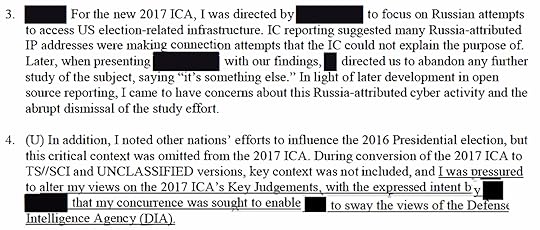
For the whistleblower, the “abrupt dismissal of the study effort” raised significant concerns about the true nature and source of the “Russia-attributed cyber activity.” They suspected their superiors were attempting to conceal how state or non-state actors closer to home may have been engaged in “Domain Name Service (DNS) record manipulation”, to falsely ascribe cyber meddling efforts to Moscow. Their anxieties only multiplied when superiors rebuffed their attempts to include references to “other nations’ efforts to influence the 2016 Presidential election” in the 2017 ICA.
The whistleblower’s “professional judgment…was multiple nations were seeking to shape the views of the US electorate,” and therefore influence their voting preferences. This assessment was based not only on relentless negative media coverage of Trump in allied countries – especially Britain, and other “NATO partners” – but the “interception of electronic communications from members of [Trump’s] incoming Presidential administration.” The source of this interception is redacted. So too is the identity of an official who repeatedly demanded the whistleblower conceal this from the National Security Council.

‘Tradecraft Standards’
The ICA’s release on January 6th 2017, 11 days prior to Trump’s inauguraration, ignited a media frenzy over the President-elect’s potential ties to Russia, and the Kremlin’s purported role in installing him in the White House. The New York Times dubbed the document a “damning and surprisingly detailed account” of Moscow’s “efforts to undermine the American electoral system.” The Washington Post boldly described it as “a remarkably blunt assessment”, and “extraordinary postmortem of a Russian assault on a pillar of American democracy.”
In reality, the ICA offered zero evidence to support any of its bombastic headline conclusions. This glaring deficit was justified on the basis “full supporting information on key elements of [Russia’s] influence campaign” was “highly classified”. Bizarrely, much of the Assessment’s content focused instead on the output of Russian media – both for domestic and international audiences – with no relevance whatsoever to the 2016 election. This included RT America coverage of topics including police brutality, fracking, and “alleged Wall Street greed.”
When the whistleblower learned the ICA was so heavily dependent on a “simplistic treatment” of “English language Russian media articles”, they expressed “substantial concern” over the “legitimacy” of the Assessment’s “analytic tradecraft”. They moreover “could not concur in good conscience based on information available,” and their “professional analytic judgement,” of a “decisive Russian preference” for Trump’s victory, as concluded by the ICA. The whistleblower thus refused to sign off on its findings.
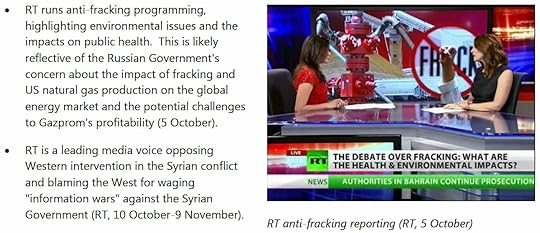 Excerpt from January 2017 ICA
Excerpt from January 2017 ICAThis was not well-received by a senior US intelligence official, name redacted. Leading up to the ICA’s release, they sought to harass and suborn the whistleblower into endorsing the Assessment. After multiple failed attempts to bully the whistleblower to “abandon” their “tradecraft standards” and simply “trust” there was “reporting you are not allowed to see,” which “if you saw it, you would agree,” the official strongly implied the whistleblower’s subsequent promotion was contingent on their agreement.
When this approach didn’t work, the “visibly frustrated” official fulminated, “I need you to agree with these judgments, so that DIA [Defense Intelligence Agency] will go along with them.” This prompted discussion between the pair about the DIA’s “supposed trust” in the whistleblower, and “the necessity” of them proving their “bona fides” as an intelligence community officer “by doing what it took to bring DIA on board as an additional [intelligence] Agency signing on to the 2017 ICA.”
Refusing to compromise on “standards, tradecraft, and ethics”, the whistleblower defied his superior’s direct order “to misrepresent my views to DIA.” While unexplored in the declassified file, the official’s desperation for the DIA to endorse the ICA is understandable. In September 2020, it was revealed the entire US intelligence community had no “confidence” in the Assessment. In fact, then-CIA director John Brennan personally wrote the report’s incendiary conclusions, before selecting a coterie of his close Agency confidantes to sign off.
Many US intelligence analysts conversely assessed Russia favoured Hillary Clinton’s victory, and viewed Trump as a potentially dangerous “wild card”. As such, creating the false impression of US intelligence community unanimity over Brennan’s concocted conclusion was of paramount importance to the CIA chief. In the end, only the Agency, FBI, and NSA publicly endorsed the ICA’s findings. Even then, the NSA – which closely monitors communications of Russian officials, and could therefore detect any high-level discussions about the 2016 election in Moscow – merely expressed “moderate confidence”.
‘Something Else’
The whistleblower was surprised the FBI expressed “high confidence” in the 2017 ICA. They were aware “as recently as September 2016,” the Bureau “pushed back” against suggestions “of Russian intent to influence” the Presidential election, believing “such a judgement would be misleading.” The whistleblower notes the FBI “altered its positions…without any new data other than the election’s unexpected result [emphasis added] and public speculation Russia had ‘hacked’ the vote – a scenario [US intelligence] judged simply did not occur.”
They were furthermore shocked to learn years later disgraced former MI6 spy Christopher Steele’s ‘Trump-Russia’ dossier was a core component of the “highly classified” material, upon which the ICA’s dynamite conclusions heavily relied. It was their understanding the ODNI viewed the dossier at the time “as non-credible sensationalism”, the Office’s chief James Clapper considered it “untrustworthy”, and Steele’s ludicrous claims “had never been taken seriously” by US intelligence more widely.
The whistleblower’s grave, myriad qualms about the Assessment’s construction led them to approach a variety of US government oversight agencies, including the Intelligence Community Inspector General, with what they knew. Despite receiving acknowledgement they “had witnessed malfeasance”, the whistleblower was stonewalled, and their evidence never appears to have reached any relevant authority, let alone been acted upon. Given the explosive nature of the whistleblower’s insider testimony, ominous questions abound over why they encountered such resistance – and where the non-Russian interference they identified truly emanated from.
The whistleblower’s account of being tasked to investigate alleged Russian hacking of “election-related infrastructure” the US intelligence community found inexplicable, only to be told to leave it alone as it was “something else”, is particularly striking. There are several explanations for this activity, all of which point to concerted attempts to falsely concoct the narrative of Russian election interference for malign purposes. For example, in September 2016, Hillary Clinton-connected lawyer Michael Sussmann approached the FBI, claiming to possess explosive evidence of Trump’s collusion with Moscow.
The material comprised DNS logs, supposedly indicating the Trump Organization used a secret server belonging to Russia’s Alfa Bank for back-channel communications with the Kremlin. This was fed to the media, and excitedly reported by certain liberal outlets prior to the election. However, The Intercept rubbished the trove, given the DNS records supplied couldn’t “prove anything at all, and certainly not ‘communication’ between Trump and Alfa.” In sum, “no one…can show that a single message was exchanged between Trump and Alfa.”
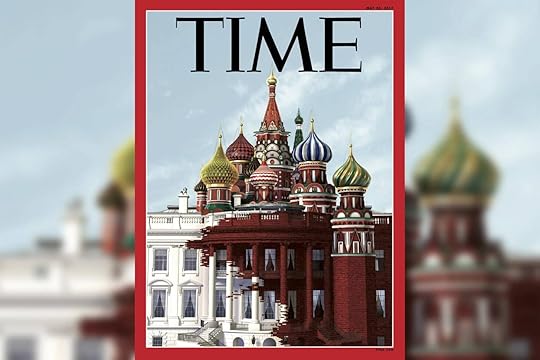 May 2017
TIME
magazine cover, depicting the White House being absorbed by the Kremlin
May 2017
TIME
magazine cover, depicting the White House being absorbed by the KremlinAn alternative may be the Department of Homeland Security was responsible for targeting election infrastructure. In December 2016, The Wall Street Journal reported an attempted hack into the state of Georgia’s voter registration database traced back to a DHS IP address. The incursion came at a time the Department was lobbying for election systems to be regarded as “critical infrastructure”, therefore making their protection part of the agency’s formal purview.
On January 6th 2017, the same day the ICA dropped, DHS secretary Jeh Johnson jubilantly announced he had designated “election infrastructure” part of the agency’s already vast domestic spying remit. He acknowledged “many state and local election officials…are opposed to this designation.” It was certainly a good day to bury bad news. And assist the CIA and Clinton campaign in furthering nonsense conspiracy theories about Russian attempts to “hack” the 2016 Presidential election, therefore hopefully invalidating its “unexpected result”.



